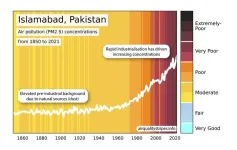(Press-News.org) University of Leeds News
Embargoed until 23 August 10:00 BST
A selection of AQ Stripes graphic images are available here
The global concentrations of one of the main air pollutants known to affect human health have been graphically illustrated for the first time by a team of scientists.
The Air Quality Stripes which were created by the University of Leeds, the University of Edinburgh, North Carolina State University, and the UK Met Office, starkly contrast the significant improvements in air quality across much of Europe with the alarming deterioration in parts of Africa and Central Asia.
The project's findings highlight both the successes and ongoing challenges in tackling air pollution worldwide.
Dr Kirsty Pringle from EPCC at the University of Edinburgh and co-director of the project, said: "Air pollution is often called the ‘invisible killer’, but these images make the invisible visible, showing the changes in particulate matter pollution over the decades.”
Dr Jim McQuaid, an Associate Professor of Atmospheric Composition in the Leeds’ School of Earth and Environment who worked on the Air Quality Stripes project with Dr Pringle, said: “The bottom line is that air pollution is one of the world's leading risk factors for death, it is thought to contribute to one in ten deaths globally.
“Our Air Quality Stripes show the huge range in trends and concentrations around the world. The stripes demonstrate that there is still more work to be done to reduce people’s exposure to poor air quality, and in some places a great deal more!”
Inspired by the world-famous climate warming stripes image, the researchers created their own illustration to plot the changing trends in outdoor concentrations of what is known as particulate matter air pollution, a mix of tiny liquid or solid particles such as dust, dirt, soot, or smoke, which are found throughout the atmosphere.
Dr Steven Turnock, a senior scientist from the UK Met Office who provided the data for the Air Quality Stripes project, said: “Presenting this scientific data as Air Quality stripes really brings into focus the stark contrast in air quality trends and people’s exposure to poor air quality depending on where they live.”
There are stripes for the capital city of every nation worldwide with two additional cities for China, India, and the United States. The research team also included their own cities of Leeds, Edinburgh, and Exeter.
The lightest blue stripes meet the World Health Organisation Air Quality Guidelines which were introduced in 2021, with all other colours exceeding the guideline values.
Data from computer simulations and satellite observations were combined to estimate the changing concentrations of particulate matter since the beginning of the industrial revolution, with the colour palette for the stripes devised by an artist who analysed over 200 online images of “air pollution” to identify the dominant colour palettes.
Key Findings:
Europe's Air Quality Gains: The images show substantial reductions in particulate matter levels across most of Europe (predominantly Western Europe). Stricter air quality regulations and technological advancements have successfully reduced particulate matter concentrations in most European cities (e.g. London, Brussels, Berlin).
Worsening Conditions in Central Asia and parts of Africa: The visualisations reveal a concerning rise in particulate matter pollution in many cities in central Asia and Africa (e.g. Islamabad, Delhi, Nairobi). Rapid urbanisation, industrial growth, and limited regulatory frameworks are contributing to this troubling trend, which poses significant health risks to local populations.
Global Disparities: The images highlight the stark disparities in air quality progress between different regions, emphasising the need for targeted international efforts to address the growing air pollution crisis in the most affected areas.
The influence of natural sources was particularly notable in some locations, these sources include desert dust and wildfires, proximity to the coast was often quite noticeable with locations such as Jakarta having lower levels than might be expected.
A cocktail of pollutants
Particulate matter, or PM2.5, have a diameter less than a 30th of the width of a human hair and can penetrate deep into our lungs easily. The smallest particles cross into the bloodstream and affect our health, and some have even been detected in the blood of unborn children.
They can come from natural sources such as volcanoes and deserts but are also produced by human activities such as industry, cars, agriculture, domestic burning, and fires arising from climate change.
PM2.5 has been linked to a very wide range of health issues ranging from breathing problems like asthma, to reduced lung health, increased likelihood of developing cancer and heart disease, and an increased risk of developing many diseases including diabetes, Alzheimer’s, and Parkinson’s.
The World Health Organisation recommends that the annual average concentration of PM2.5 should not exceed a concentration of 5 micrograms per cubic meter air (5 ug/m³). This new guideline is a concentration which is generally classed as very good air quality. It is important to remember that there is NO safe level of PM2.5 recognised by medical science. At present, 99% of the world’s population live with concentrations above this value, with the highest PM2.5 levels typically found in low- and middle-income countries.
The AQ stripes use an annual average to take account of the ups and downs due to changes in weather patterns throughout the year, and to make comparison between locations simpler. However the researchers point out that even short-term exposure to very high levels can quickly have acute health effects requiring medical treatment.
Dr McQuaid added: “We created these to try to illustrate the complex data that computer models generate, into something that is much easier to understand.
“Strangely, one of the major headaches for us was the colour scheme. We finally went for blue to black, representing nice clean blue skies, through to black for extremely high levels of pollution.
“In the end we contacted a colleague in the US (Douglas Hamilton) and he worked with one of his team to create a colour scheme using an internet search of images tagged as ‘air pollution’ and they came up with what we finally went with. It was very similar to what we already had, but great to get external validation.
“To me it’s all about that lightbulb moment when someone understands it; that sudden ‘oh yeah now I get it!’ I wanted it to be simple enough that non-experts could look at it and be able to understand it without having done science since leaving school. “
Dr Pringle added: "The images show that it is possible to reduce air pollution; the air in many cities in Europe is much cleaner now than it was 100 years ago, and this is improving our health. We really hope similar improvements can be achieved across the globe."
The Air Quality Stripes follow in the footsteps of the Climate Warming Stripes which were created by Professor Ed Hawkins at the National Centre for Atmospheric Science and University of Reading in 2018 and have since become very widely used as a visual representation of the Earth’s warming climate.
Professor Hawkin’s work has since inspired the creation of the Biodiversity Stripes which show biodiversity loss, and Ocean Acidification Stripes.
Further information
A selection of AQ Stripes graphic images are available here
The initiative is a collaboration between leading environmental research institutions and data science organisations EPCC and CEMAC. Led by the universities of Leeds and Edinburgh, the project aims to provide valuable insights into air quality trends and support efforts to mitigate air pollution worldwide. EPCC at the University of Edinburgh is a leading data science hub. The work was supported by the Software Sustainability Institute which is dedicated to supporting researchers in their use of software.
The University of Leeds and the University of Edinburgh are both members of the Met Office Academic Partnership (MOAP)
For more information, please visit airqualitystripes.info
For media enquiries, Please contact the University of Leeds press office via pressoffice@leeds.ac.uk
University of Leeds
The University of Leeds is one of the largest higher education institutions in the UK, with more than 40,000 students from more than 137 different countries. We are renowned globally for the quality of our teaching and research.
We are a values-driven university, and we harness our expertise in research and education to help shape a better future for humanity, working through collaboration to tackle inequalities, achieve societal impact and drive change.
The University is a member of the Russell Group of research-intensive universities, and is a major partner in the Alan Turing, Rosalind Franklin and Royce Institutes www.leeds.ac.uk
Follow University of Leeds or tag us in to coverage: Twitter | Facebook | LinkedIn | Instagram
END
New images reveal global air quality trends
2024-08-23
ELSE PRESS RELEASES FROM THIS DATE:
Spike mutations help SARS-CoV-2 infect the brain
2024-08-23
Still unknown what causes neurological complications of COVID-19 including ‘long COVID,’ ‘brain fog’ and loss of taste and smell
Viruses with a deletion in the spike protein are better able to infect the brains of mice
‘These findings suggest there might be treatments that could work better to clear the virus from the brain’
CHICAGO --- Scientists have discovered a mutation in SARS-CoV-2, the virus that causes COVID-19, that plays a key role in its ability to infect the central nervous system. The findings may help scientists understand its neurological symptoms and the mystery of “long COVID,” and ...
Pesco-vegetarian diets best for reducing risk of death in elderly
2024-08-23
A variety of vegetarian diets appear to protect against risk of mortality and contributing conditions, with a pesco-vegetarian diet — which includes fish — providing the most protection against risk in very elderly people, according to a new study.
Researchers at Loma Linda University Health found that vegetarian diets are associated with lower risk for all-cause mortality and many cause-specific mortalities, especially among males and in middle-aged subjects. However, slightly higher risks were observed among very elderly vegetarians for neurological conditions such as stroke, dementia, and Parkinson’s Disease. Despite this, ...
Men infected with high-risk types of HPV could struggle with fertility
2024-08-23
Cervical cancer, the fourth most common cancer type in women, causes approximately 350,000 deaths each year, mainly in middle- and low-income countries. Human papillomavirus (HPV) infection is known to cause 95% of these cases. Public health authorities in 37 countries currently vaccinate girls between nine and 14 years of age, before they typically start sexual activity.
HPV is also known to increase the risk of genital warts and cancers of the penis, anus, mouth, and throat in infected men, which is one of the reasons why the WHO and the US Center for Disease Control (CDC) ...
Scientists call for an update in environmental decision making that takes human rights into account
2024-08-23
Human wellbeing is connected to nature for food, climate regulation and culture, making the protection of nature a human rights matter.
Added to that, recent developments in international human rights law highlight that governments need to consider human-nature connections when making decisions that may affect the environment.
In a commentary published in npj Ocean Sustainability, an interdisciplinary group of researchers – including experts in ecosystem services, environmental governance, deep-sea ecology, and law – underscore that these developments should prompt a rethink of how any environmental decisions that hold the potential to impact biodiversity ...
Terahertz detection: a novel approach to real-time monitoring of perovskite ageing
2024-08-23
Hybrid perovskites have great potential for use in advanced electronic devices like solar cells and LEDs. However, one major issue holding them back is that they don't last as long as needed for widespread commercial use. As these materials age, their performance drops, which is a big problem for both researchers and companies. To tackle this issue, it's important not only to improve the stability of these perovskites but also to develop methods for detecting how they age in real-time. By understanding how these materials degrade over time, we can make them more durable and efficient.
In a recent study, researchers led by Prof. Yiwen Sun at Shenzhen University used the terahertz ...
Colorful traits in primates ease tensions between groups
2024-08-23
Primate ornamentation plays a crucial role in communication not only within social groups but also between them, according to a new study. The research reveals that the males of species with overlapping home ranges often display vibrant colors or elaborate features, traits that may help reduce intergroup aggression by enabling quick assessments of potential rivals.
Ornaments are sexually selected traits that serve as powerful signals, often indicating an individual’s genetic quality, health or physical strength. These differences ...
Sylvester Cancer Tip Sheet for August 2024
2024-08-23
AUGUST 2024 TIP SHEET: A mouthwash-like rinse to predict head and neck cancer recurrence, new research identifies biomarkers to predict which colon cancer patients benefit from adjuvant chemotherapy, the Dolphins Cancer Challenge and StacheStrong team up to boost brain cancer research, the CDC issues anal cancer screening guidelines for HIV patients based partly on research at Sylvester, and three Sylvester physicians who become the latest early-career faculty scholars are highlighted in this month’s tip sheet from Sylvester Comprehensive ...
Weight loss drug’s heart benefits extend to people with heart failure
2024-08-23
The anti-obesity medication semaglutide may help to prevent heart attacks and other major adverse cardiac events among overweight people who have cardiovascular disease, whether or not they also have heart failure, according to a new study led by UCL’s Professor John Deanfield.
The results follow previous research* from the same international team finding that weekly injections of semaglutide were linked to a 20% reduction in major adverse cardiac events (MACE) such as heart attacks and strokes for people with obesity or who were overweight and had cardiovascular disease.
The ...
Declining senses can impact mental health and loneliness in aging adults
2024-08-23
Most people — up to 94% of U.S. adults — experience at least some dulling of their senses with age, finding themselves squinting at screens, craving stronger flavors, and missing snatches of conversations more and more frequently. Researchers at the University of Chicago Medicine are looking into how these changes can go beyond mere inconvenience and actually worsen overall mental health in older adults.
“When your senses decline, you can't experience the world as well,” said Jayant Pinto, MD, a physician ...
NASA’s EXCITE mission prepared for scientific balloon flight
2024-08-23
Scientists and engineers are ready to fly an infrared mission called EXCITE (EXoplanet Climate Infrared TElescope) to the edge of space.
EXCITE is designed to study atmospheres around exoplanets, or worlds beyond our solar system, during circumpolar long-duration scientific balloon flights. But first, it must complete a test flight during NASA’s fall 2024 scientific ballooning campaign from Fort Sumner, New Mexico.
“EXCITE can give us a three-dimensional picture of a planet’s atmosphere and temperature by collecting data the whole time the world orbits its star,” said Peter Nagler, the mission’s principal ...





